► Clio vs 208 in heart of Paris
► French superminis in their home
► Which comes out on top?
Notre Dame stands defiant, burnt, broken but unbowed on the Ile de la Cité. We drive past, seven months since fire ravaged her, and see her swaddled in scaffolding, large cranes cradling protectively. The medieval cathedral’s twin towers, tall and proud, look untouched. Her famous needle-like oak spire is now ashes. The ancient roof that clad the vaulted stone ceiling has disappeared, molten lead and charred wood.
Paris is studded with iconic buildings, of course, and they all change and evolve, just like Notre Dame. The twin towers were built in the 1200s. The flying buttresses came a century later. The recently destroyed spire was added in the 1800s. A new spire, probably to a modern 21st century design, will come.
Best superminis: a CAR guide
It’s a similar story of evolution with the Eiffel Tower, the Louvre (its glass pyramid was added in 1989) and the Musée d’Orsay, one-time Beaux-Arts train station, now the world’s finest Impressionist art gallery. We pass them all, as we tour Paris.
The Diamond and the Lion
We’re driving the latest versions of two French motoring icons, which have – like this city’s great buildings – evolved over time. The supermini is France’s favourite breed of car, and no two have advanced the art better than the Renault Clio (and the R5 that preceded it) or the Peugeot 205 and its successors. For those too young to remember France’s true automotive belle epoque (the ’50s, ’60s and early ’70s, when Citroën innovated like no car maker before or since), the Clio and 205 are probably France’s best-known and best-loved vehicles.
We bring their successors to the City of Light and to the city of their creation. Both are brand new, ride on new platforms and are much improved. They also showcase a French car industry, once written off as the sick man of Europe, in surprising good health. Especially highly profitable Peugeot, now developing a relationship with FCA.
The latest 208 is collected from Peugeot’s HQ in Paris; UK deliveries had not yet begun. It attracts admiring glances, in fact rather more interest than any big-volume hatch I can remember for ages. And it’s not just the electric Faro Yellow paintjob, either. Normally taciturn Parisians give it the thumbs up and smile as we stop and photograph it alongside city landmarks, battling for space with Chinese tourists taking selfies.
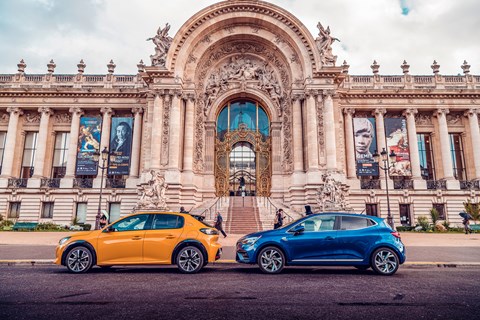
The new Clio is driven down from Peterborough by features editor James Taylor and staff writer Jake Groves. They talk of a much-improved car over the previous Clio, especially in cabin quality. Taylor learned to drive in a Clio and owned a 306. Groves wasn’t even born when the first Clio was launched in 1990. Since then, it’s been the world’s best selling French car.
Tellingly, Parisians ignore the new Clio, treating it with their usual sang-froid. All-new it may be, but it looks just like the old one. A same-style version of France’s most popular car is about as familiar in this part of the world as red cafe awnings and well-dressed women leading small dogs. Mind you, it’s still a distinctively proportioned hatchback, with its long bonnet, shapely pert haunches and big diamond grille. This gives it a sporty Alfa-like profile (think Alfasud, Alfa 147 or Giulietta), or so design director Laurens van den Acker told me years ago when the Clio Mk4 was launched. It even had Alfa-style rear door handles hidden in the C-pillar. The new gen-five Clio uses the same styling template and tricks but is wider, lower, shorter and has an even bolder grille. Also unusual in this class is the long wheelbase; 43mm longer than the 208, and noticeably longer than either rival Polo or Fiesta. It’s also lighter than before, although – like-for-like – about 200kg weightier than the commendably featherweight 208.
Despite the familiar clothes, the Clio rides on an all-new Renault-Nissan platform, as used on the latest Juke. Our car is a top-spec RS Line, complete with four-cylinder 1.3-litre petrol unit and seven-speed dual-clutch auto, yours for just over £20,000. France’s car industry is renowned for its innovative suspension designs, but on the new Clio we find conventional MacPherson struts and a rear torsion beam axle – and a ride quality that is acceptable if not exceptional, as we shall see.
The new 208 is more eye-catching. It’s a striking car, complemented by those distinctive LED blade-like running lights front and rear. It’s nicely proportioned and its road stance is excellent, helped by its low ride height. Both these cars are squat by class standards, more ground hugging than the Fiesta or Polo. The 208 is especially low. Ours is top-spec GT Line, a direct rival to the Clio’s RS Line, and comes with the 1.5 four-cylinder HDi diesel and six-speed manual ‘box. It’s £22,200, so a touch more than the Clio. The like-for-like petrol 1.2 model, sadly unavailable, is also about £2000 more than the Clio.
As with the Renault, the new 208 sits on a new platform, also seen on the latest Vauxhall Corsa. The suspension is conventional: front struts and rear torsion beam. The fine 205 which started this bloodline had a particularly ingenious and compact version of the torsion beam (or twist-beam) suspension. Its boot was unfettered by suspension intrusion.
Heritage at home
And what a fine car that first 205 was! Launched in 1983, it was this magazine’s car of the decade for the ’80s. Unlike some cars whose appeal is enduring, it was not regarded as either revolutionary or futuristic at launch. It was no Mini, no Fiat Topolino, no Renault 4 (great grand-daddy of today’s Clio). Instead it featured a set of conventional components organised more intelligently than in any small car before.
The design was outstanding, a joint effort by the Italian styling studio Pininfarina, creator of most of the finest Ferraris, and Peugeot’s in-house stylists. It was simple in style, finely proportioned, and when various revisions came through its 15-year life – nicer dashboard, better trim – the outside was left unchanged. Peugeot’s designers felt it could not be improved. The car’s enduring sales appeal suggests customers agreed.
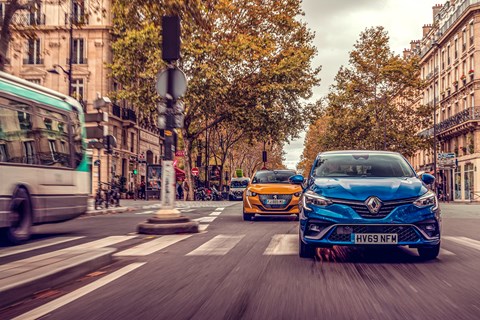
It was roomy, rode well, and the 1.9 GTI version was the world’s best hot hatch of its day. It was the best supermini when launched, was still the best as the ’80s morphed into the ’90s and stayed competitive until its death. It was replaced by the less distinguished 206, in turn succeeded by the drearier 207, replaced by the comely and much improved (but still far from special) first-generation 208. I have owned two 205s. The first was a 1.6 GTI, later replaced by a four-door 205 when the Green family expanded. I still maintain the supermini is the perfectly sized car for a family of four, especially for urban dwellers. For five, move up to the Golf class. Anything bigger is needless excess, a waste of road space, metal and fuel.
So, after the disappointments of 206, 207 and first 208, Peugeot was due a return to form. The new 208 delivers, easily Peugeot’s best supermini since the 205. Its sculpted style also has pleasing overtones of the old timer.
It is a similar story on the other side of Paris, at Renault’s HQ. Renault was once the world’s great small car pioneer, alongside Fiat. The Renault 5, precursor to the first Clio, was one of the first modern superminis when launched in 1972, many years before Ford, Volkswagen, GM (or Peugeot) got in on the act.
Mechanicals came from the marvellous old Renault 4, an early hatchback pioneer. This included a longitudinally mounted four-cylinder engine driving the front wheels, and soft and supple torsion-bar suspension, perfect for Parisian cobbles and a relaxed D-road gait. It also had the old R4’s dash-mounted gearshift, liberating front space.

The second generation R5 of 1984, the Supercinq, had a new platform, featuring transverse engine and strut front suspension. The great supermini technical convergence was under way. This R5 was designed by Marcello Gandini of Lamborghini (and Lancia Stratos) fame. So just as Peugeot turned to an Italian sports car design icon, Pininfarina, to give its 205 presence and style, so did Renault with its second and final R5.
The Clio that succeeded the R5, 30 years ago, was cute if technically unadventurous. I owned an early Clio, the basic 1.2 version (just 825kg) and it did a fine job until the Green family expanded to five. Its major appeal was its chic styling. It always felt French, and the basic spec of my car made it seem even more Gallic: the French are traditionally among the most common-sensical of car buyers and eschew useless fripperies and adornments, including pricey premium cars.
Drive a Clio in Streatham, Stratford or Southend and there is the promise of motoring down the Champs-Élysées on a fine spring day with the plane trees (London Planes, but don’t tell the Parisians) in full bloom. Driving my old Clio was like eating a delicious comté or drinking a decent Chablis: it always felt felicitously French.
Carving up the City of Light
So we have two cars with history, in a city oozing heritage. Do these cars still sprinkle French magic dust on the supermini sector, just as the 205 and R5/Clio did? Yes, they do. Their standalone style and finely wrought new cabins see to that. The French makers have decided that their priorities are design and craftsmanship, time-honoured French qualities. These are highly attractive virtues to 2020 car buyers.
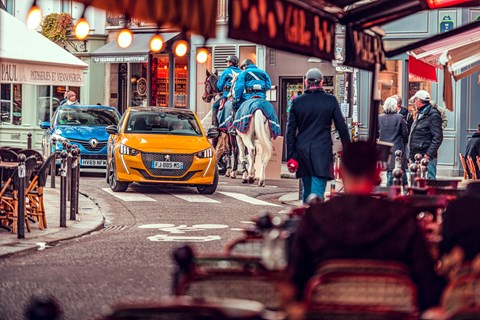
On the 208, we find a cabin of high-quality materials and avant-garde design, including a 3D instrument panel, its information projected onto different layers. It is customisable and the graphics are sharp and colourful. A 10-inch-wide horizontal central touchscreen has a row of old-fashioned piano-key toggles below for short cuts to basic controls, such as climate settings. None of us find the user interface very intuitive, although its range of connected functions is extensive, from CarPlay to 3D navigation to overhead view parking. As with the Clio, it also bristles with active safety technologies, ranging from adaptive cruise control with auto stop and go (standard on our GT Line), low-speed active safety braking and active high beam. Our Peugeot has more standard tech than many big executive saloons. The Renault is very nearly as well equipped. In-car tech completes the trinity of stand-out qualities – on top of design and cabin craftsmanship – which differentiate these French superminis from most rivals.
The 208’s steering wheel is unusually small, as was the 205’s, and it helps give a kart-like agility as the little Pug zips through Parisian traffic. Steering is lighter and less feelsome than the Clio’s, and some way behind the Fiesta, still the dynamic star of the class. Mind you, it’s perfect for town. Peugeot has not prioritised handling, steering and driving fluency. The 208 is capable here, but not outstanding, unlike the 205 of fond memory. Peugeot now judges, probably and sadly correctly, that this is not a priority for most.
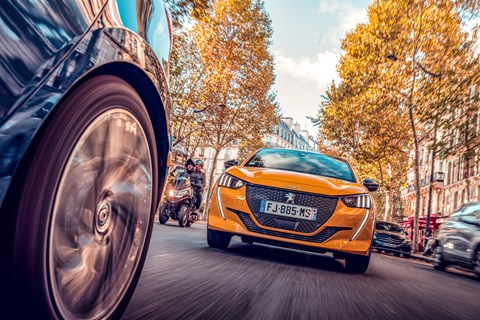
Ride, too, is acceptable, if not special. On big 17-inch wheels it navigates bumps with more suppleness than the similarly shod Clio, but it has none of the cobble-taming cushioning that so distinguished older Peugeots and Renaults. Nor does it ride as well as the Polo. A French car that is firmer than a German car! Sacré bleu! Mind you, we all love the soft-cushioned 208 seats, so supportive, so squishy, and so delightfully old-school French.
The Clio has a very familiar shape but, inside, existing owners will be delighted with the transformation. The cabin is solid, classy, well finished and looks Benz or BMW expensive. It’s way more conventional than the 208’s futuristic cockpit. Only the (incongruously) big central iPad-shaped infotainment screen seems out-of-the-ordinary. It works well, though the nav frequently lags behind, not ideal as we attempt to navigate confusing Parisian streets.
Steering feel is better than the 208’s, and it’s sharper than the old Clio’s. Mind you, it can’t match the mighty Ford Fiesta – the supermini’s dynamic standard bearer – for driving precision. Its seven-speed dual-clutch auto occasionally struggles crawling through Paris, becoming clunky. Taylor and Groves found it quiet and comfortable on the autoroute to Paris, a very grown-up and capable car. So we find two appealing new French superminis, both offering stand-out style and cabin craftsmanship, decent back-seat room (and in the Clio a massive boot, bigger than a Golf’s). We also find good if not class-leading driving pleasure.
Final thoughts
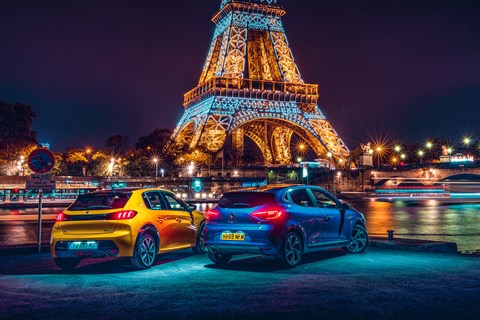
They’re a notch or two above any Korean or Japanese rival in design, dynamics and distinctiveness. The Polo is roomier and rides better, the Fiesta steers with more precision and zest, especially when speed builds and corners sharpen. But for all-round desirability, these are probably now the stand-out cars in their class.
After a decade or two of drift and indecision, it’s a welcome return to form for the French. And if they don’t quite scale the same elysian heights as the original 205, where dynamic excellence mingled with driving appeal and design genius, then that may be more a reflection of buyer priorities than loss of engineering ambition.
Of the two, I’d buy the Peugeot 208. It’s more adventurous and dreams bigger. And if there is some 205 history and heritage on top, then that just adds to the appeal.
Check out more best CAR lists